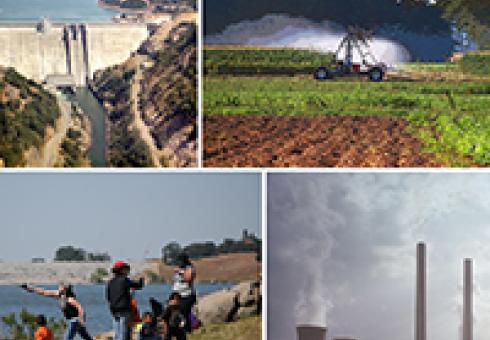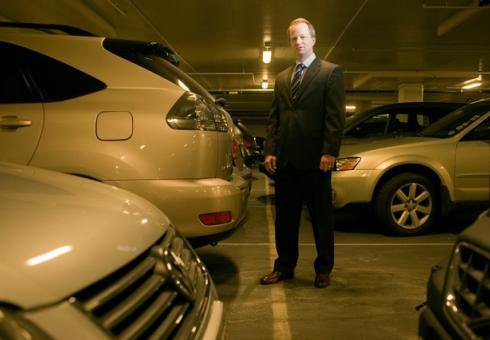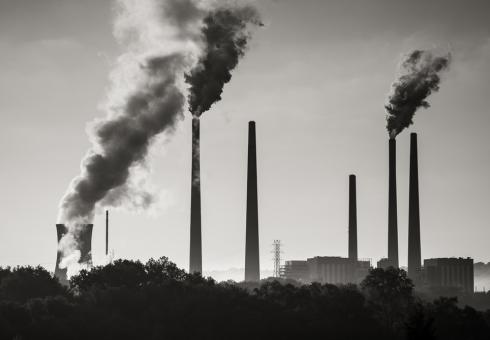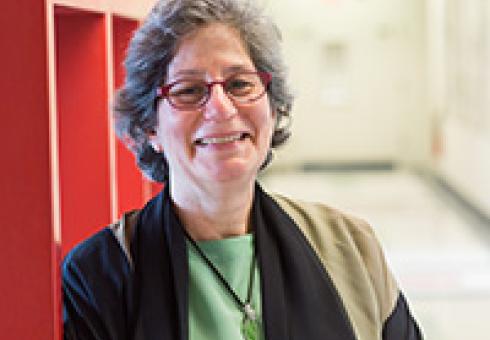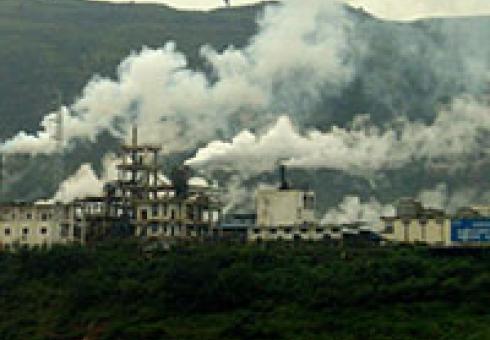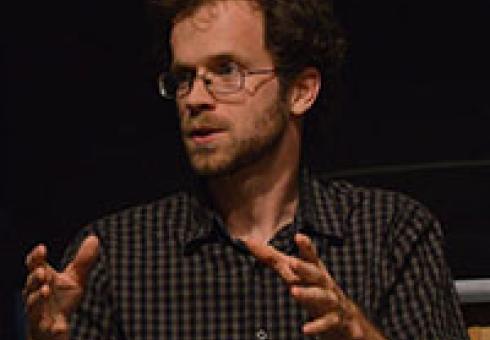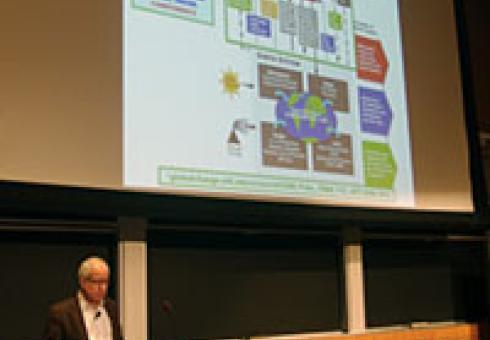CS3 In the News
MIT Energy Initiative report provides recommendations for reductions in light-duty vehicle energy use and greenhouse gas emissions
Study led by Joint Program Research Affiliate Hanquin Tian; coauthors include JP Co-Director Ronald Prinn and Research Affiliates Jerry Melillo and Eri Saikawa
Joint Program Co-Director John Reilly featured in CLP New Horizons
The following article appeared in CLP New Horizons, a compendium of news and perspectives on how to move the Asia-Pacific region toward a more sustainable energy future:
John Reilly | MIT Joint Program on the Science and Policy of Global Change
We live in a world where water, energy, land and the environment are inextricably linked. For example, water is used to produce electricity from hydropower as well as for thermal cooling. Water withdrawals for agriculture—the world’s largest consumer of water—deplete rivers and streams, thereby impacting freshwater ecosystems. Such ecosystems are also threatened by the discharge of water from power stations, which increases water temperature, and by the collection of water in large dams.
Dams not only produce hydropower but also store water from spring snowmelt or rainy seasons for use in irrigation during dry spells, and provide recreational opportunities as well. Use of water for hydropower, irrigation and recreation requires a careful balance. The availability of water for irrigation will partly determine land use, and how land is managed can affect runoff and sedimentation in reservoirs and other bodies of water, potentially degrading water quality and ecosystems.
Other energy, industry and domestic uses of water can be substantial in areas where water resources are limited. For example, there’s concern that development of China’s shale gas resources, located in dryer western regions of China, could be constrained by water availability.
Global changes
In Asia, population growth and economic development are increasing demand for water, food and energy, exacerbating conflicts among land, water and energy needs. In addition, climate change is expected to significantly affect agricultural productivity worldwide and alter the supply of water. While global warming will, in general, speed the hydrological cycle and lead to more precipitation, rainfall will be unevenly spread across the globe, and many currently water-stressed areas will become more stressed.
Efforts to reduce greenhouse gas emissions will change the energy mix, and if renewable sources like wind and solar become more widely used, smaller water withdrawals will be needed for thermal cooling. On the other hand, if biomass energy is part of the mitigation solution, that could increase pressure on land and indirectly on water in order to increase food crop yields.
Rising concerns for fresh water ecosystems may lead to restrictions on the amount of water withdrawn from rivers and lakes. Many areas are already considered overused. In addition, areas relying on groundwater resources may become unsustainable.
Building a more sustainable future
Businesses can take a number of steps to build a more sustainable future. First, by reducing greenhouse gas (GHG) emissions—ideally supported by government incentives—they can limit the amount of climate change in the coming decades. Second, they can adopt practices that improve water use efficiency and maintain water quality. Third, they can take climate change into consideration when planning the location of new facilities, while noting the uncertainties in climate models.
Our recent research indicates that water stress will increase in China and India. In China, climate change and growth are expected to exacerbate water stress; in India, climate change is projected to have a neutral effect on water supplies, although growth will likely increase water stress. In mainland Southeast Asia, climate change is expected to increase water supplies, partly offsetting the impact of growth.
In all regions, the range of possibilities are far wider than the historical variability in water resources. This highlights the difficulty involved in facilities planning.
References
Modeling U.S. water resources under climate change Blanc, É., K. Strzepek, A. Schlosser, H. Jacoby, A. Gueneau, C. Fant, S. Rausch and J. Reilly, Earth's Future, 2(4): 197–224 (doi:10.1002/2013EF000214), 2014
Climate change impacts and greenhouse gas mitigation effects on U.S. water quality Boehlert, B., K.M. Strzepek, S.C. Chapra, C. Fant, Y. Gebretsadik, M. Lickley, R. Swanson, A. McCluskey, J.E. Neumann and J. Martinich, Journal of Advances in Modeling Earth Systems, 7(3): 1326–1338, 2015
Impacts on Resources and Climate of Projected Economic and Population Growth Patterns Reilly, J. , The Bridge (National Academy of Engineering), 45(2): 6–15, 2015
The future of global water stress: An integrated assessment Schlosser, C.A., K. Strzepek, X. Gao, C. Fant, É. Blanc, S. Paltsev, H. Jacoby, J. Reilly and A. Gueneau, Earth's Future, 2(8): 341-361 (doi:10.1002/2014EF000238), 2014
A Framework for Analysis of the Uncertainty of Socioeconomic Growth and Climate Change on the Risk of Water Stress: a Case Study in Asia Fant, C., C.A. Schlosser, X. Gao, K. Strzepek and J. Reilly, Joint Program Report Series, 48 p., 2014
Four-part plan signals effort to build on last year’s climate action plan, and an end to months-long protest
David L. Chandler | MIT News Office
After months of dialog and negotiation, the student-led group Fossil Free MIT and the MIT administration have reached an agreement that has brought to an end the group’s sit-in, which began on October 22, in front of the administrative offices.
Both sides say that the new agreement (see text below) provides a positive set of plans that will help to meet the essential goals that the student group has been advocating, and will set in motion activities and structures to help ensure that MIT makes significant progress in dramatically reducing its own use of fossil fuels and in promoting serious local, national, and international goals toward reducing human impact on the Earth’s climate.
Members of Fossil Free MIT have been meeting for months with MIT’s Vice President for Research Maria Zuber, and they have identified four areas where they will work together to build on and enhance MIT’s “Plan for Action” announced last fall. Zuber, who was charged with implementing those plans, will work with the student-led group to advance these four specific goals.
The four action areas are: Moving toward campus carbon neutrality as soon as possible; establishing a climate action advisory committee to consult on the implementation of the Plan for Action; developing a set of strategies and benchmarks for MIT’s engagement with industry, government, and other institutions; and convening a forum on the ethics of the climate issue.
“For months now, I have been meeting regularly with several members of Fossil Free MIT, and I deeply admire their commitment to the cause and the honorable way they have pursued it,” said Zuber. “It is crucial that MIT seize a leadership role in addressing the urgent issue of climate change, and I believe that this agreement puts us in an even stronger position to lead effectively and successfully.”
A member of Fossil Free MIT, speaking for the group, says the group “continues to support targeted divestment of the endowment from fossil fuel companies, and we see this as complementary to industry engagement and MIT's Climate Action Plan. We're excited to keep working with the administration on areas of common ground.”
Zuber says that she, along with MIT students, faculty, staff, and alumni, are moving forward on the four basic components of this new agreement.
- For the campus carbon reduction goal reflected in the plan – a reduction of 32 percent by 2030 – there is agreement that this is to be seen as a floor, not a ceiling. The Institute will work to do everything feasible to improve on that goal, and to reinforce its stated aspiration to reach carbon neutrality as soon as possible.
- The new Climate Action Advisory Committee will be set up, including representatives of MIT undergraduate and graduate students, postdocs, faculty, staff, MIT Corporation members, and alumni. The group will be inviting all members of the MIT community to work collaboratively and bring in ideas to take advantage of this pool of talent and expertise.
- That committee will also work on developing benchmarks and guidelines on how to assess the effectiveness of MIT’s efforts to engage on climate change issues with outside institutions, including industry and government.
- Working with the whole MIT community, Zuber’s office will convene a forum to explore the issues involved in the ethical dimensions of climate change, examining the ethical responsibilities of all the different parties involved.
MIT President L. Rafael Reif praised the agreement, saying, “To the student negotiators from Fossil Free MIT and to Vice President Zuber: I am inspired by both your conduct and your results. Through respectful discussion, creative thinking, and sheer persistence, you transformed a moment of impasse into an opportunity to accelerate progress against climate change. I hope we can all join now, with renewed momentum, in the urgent work ahead.”
Below is the agreement reached by Fossil Free MIT and the MIT administration.
Shared Statement on Climate Action
March 1, 2016
Over the course of many productive conversations during the last few months, Maria Zuber, MIT’s Vice President for Research, and members of the student-led group Fossil Free MIT (FFMIT) have discussed their shared interests with respect to accelerating solutions to the urgent problem of global climate change.
The conversations arose from concerns articulated by FFMIT on three issues: the trajectory of campus carbon emissions reduction; investments in fossil fuel companies through MIT’s endowment; and the role of disinformation in hindering action in the global debate over climate change. Vice President Zuber has listened to these concerns, described some of the infrastructural challenges associated with decarbonizing campus energy generation, reinforced the senior MIT administration’s belief in a strategy of constructive engagement with industry, and reiterated its support for providing accurate, high-quality information on climate change to the public.
Based on these conversations, Vice President Zuber and FFMIT have identified four areas for building upon and enhancing MIT’s Plan for Action on Climate Change, released in October 2015. As MIT’s Vice President for Research, Professor Zuber has oversight responsibility for the plan. She and FFMIT intend to work jointly to bring these four ideas to fruition.
First, the MIT senior administration and FFMIT agree that the campus carbon emissions reduction goal included in the plan – a 32% reduction by 2030 – is a floor, not a ceiling. As MIT’s Office of Sustainability has articulated, the campus aspires to carbon neutrality as soon as possible. The Office of Sustainability, which recently published MIT’s first campus greenhouse gas inventory, has challenged the community to advance solutions to help achieve this goal, and intends to report yearly on progress.
Second, Vice President Zuber will establish and chair a climate action advisory committee to advise and consult with her on the implementation and ongoing assessment of MIT’s Plan for Action. The committee’s membership will include faculty, students, postdocs, staff, Corporation members and alumni who wish to engage in the process in an open, collaborative way, inviting implementation ideas from across the MIT community and bringing to bear the full depth and breadth of the MIT community’s talent, experience, expertise, and creativity.
Third, because a strategy of engagement with industry, government, and other institutions lies at the core of MIT’s Plan for Action on Climate Change, the new climate action advisory committee will provide advice to identify, develop, and publish engagement strategies and benchmarks. Benchmarks will include inputs and activities, such as number of meetings held, in addition to outcomes aligned with a 2°C future: for example, these may include steps taken by industry to develop and implement 2°C business strategies and to support a 2°C public policy framework. The committee will also provide advice and input on an annual report to be produced by the Office of the Vice President for Research to assess MIT’s progress in implementing the Plan for Action and engagement partners’ response to the climate challenge.
Fourth, working with students, faculty, staff, alumni and partners, Vice President Zuber willconvene a forum to explore ethical dimensions of the climate issue. The forum will seek to shed light on critical questions like the ethical responsibilities confronting all stakeholders – countries, industries, companies, shareholders, institutions, individuals, and different generations – if we are to limit the increase in average global temperatures to 2°C over pre-industrial levels, as well as the ethical dimensions of climate change communication.
Photo: Christopher Harting/AboveSummit
Joint Program Co-Director Ronald Prinn quoted in front-page NY Times Article
“This, for me, is such a big shock,” said Prinn. “To think that you could stop measurements or throw out the people, that doesn’t make any sense to me and to many, many other people around the world.”
Not without a carbon tax, suggests a study by CEEPR Director Christopher Knittel
In recent years, proponents of clean energy have taken heart in the falling prices of solar and wind power, hoping they will drive an energy revolution. But a new study co-authored by an MIT professor suggests otherwise.
Noelle Selin, Amanda Giang share their perspective in The Conversation
Over 300,000 babies every year are born in the United States with levels of mercury that put them at risk of neurological and developmental problems. How much would you be willing to spend to reduce this number?
Susan Solomon co-authors study in Nature Climate Change
A large group of climate scientists has made a bracing statement in the journal Nature Climate Change, arguing that we are mistaken if we think global warming is only a matter of the next 100 years or so.
Auburn U., MIT researchers link lower crop yields to higher ozone levels
MIT attendees of COP21 share experiences, perspectives on outcomes
Experts examine how MIT can be most effective in addressing climate-change issues
John Reilly interviewed on PRI's The World
Jason Margolis | PRI’s The World
If you’re in the oil business, you might think your best days are in the rear-view mirror. Oil is selling for rock-bottom prices. Your product is blamed for destroying the planet. And here’s what the leader of the free world thinks of oil.
“We’ve got to accelerate the transition away from old, dirtier energy sources. Rather than subsidize the past, we should invest in the future,” said President Obama during his recent State of the Union address.
To state the obvious though, if you’re an oil company, you produce oil. Energy economist John Reilly at the MIT Sloan School of Management says companies like ExxonMobil and Chevron are facing a classic business challenge.
“Could the horse and buggy manufacturers become automobile producers? Or is some other company going to because they’re more innovative, or not bound by what they’re already doing?" asks Reilly.
But before we pity the poor oil companies, remember, these are the richest companies in the world.
“Most of them have lots of cash. And so, if there’s a successful alternative, if they don’t develop it, they probably can acquire those companies and transition that way,” says Reilly.
. . .
Read the full article and hear the broadcast at Public Radio International’s The World.
Photo: Norwegian company Statoil plans to build the first floating wind farm off the Scottish coast. (Photo courtesy of Statoil)



